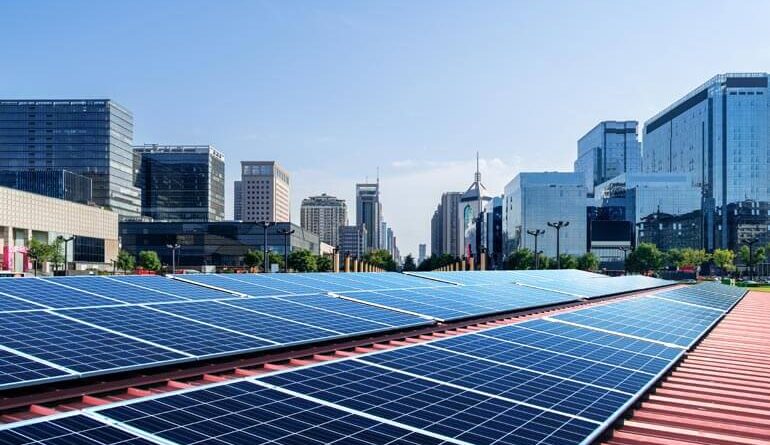Know About The Features Of Commercial Solar Panels: A Detailed Guide
Many major commercial and industrial establishments in India have walked the path of going solar. The primary goals that make businesses switch to solar include reducing electricity bills and decarbonizing the environment to protect the planet.
Talking about commercial solar systems brings us to the question – what features to look for when choosing commercial solar panels? This guide has been curated to walk you through the ins and outs of solar panels, their cost, and more.
Take a plunge and explore commercial solar space like never before.
Types of commercial solar panels
Polycrystalline and monocrystalline solar panels are India’s two major types of commercial solar panels. Even bifacial panels exist, but their ROI isn’t as profitable as expected. Hence, they’re not that popular at the moment.
At the moment, a significant number of installations use polycrystalline panels. But monocrystalline solar panels are the favorites that will replace all other commercial solar panels in the future. The type you choose depends on many factors, which we will discuss later in this guide.
Top features of commercial solar panels to keep an eye on
You know by now that there are two types of panels currently in the game – polycrystalline and monocrystalline.
Let’s start with the features of polycrystalline solar panels first.
- Efficiency – The efficiency of polycrystalline panels ranges between 16% to 17%. These panels are made of many silicon crystals; hence, they are also known as multi-crystalline panels.
- Cost and affordability – The current market cost of poly panels is approximately ₹25.5 per watt. They’re the most affordable commercial solar panels at the moment.
- Degradation rate – The life of tier-1 (branded) solar panels (poly and mono) is at least 25 years. However, as the panels age, their silicon degrades too. It’s a natural phenomenon that cannot be stopped. The annual degradation rate of polycrystalline panels is 0.7%. These panels still work at an efficiency of 70% after 25 years.
Now, let’s talk about the features of monocrystalline solar panels.
- Efficiency – Monocrystalline panels got their name because they’re made up of one single silicon crystal. Hence, their efficiency is also higher (19% to 20%).
- Cost and affordability – It shouldn’t take second-guessing that mono panels are costlier than poly panels because they are more efficient. Their current market cost is approximately ₹31.5 per watt.
- Degradation rate – If you wanted another reason to justify the higher cost of monocrystalline panels, then this is it. The annual degradation rate of these panels is 0.5%, which is less than polycrystalline panels. Hence, their power generation capacity will also be higher after 25 years.
Comparison between the features of commercial solar panels
When installing a solar system, you must weigh all the features of different panels and then compare them with your needs, such as your budget, the kind of rooftop you have, the rooftop space, etc.
Let’s walk you through a quick comparison table between the two types of panels we already discussed. Following this, we will help you understand how to make the correct choice.
| Polycrystalline solar panels | Monocrystalline solar panels |
| Efficiency ranges between 16-17% | Efficiency ranges between 19-20% |
| Requires more installation space | Requires less installation space |
| Costs approximately ₹25.5 per watt | Costs approximately ₹31.5 per watt |
| Degrades @ 0.7% yearly | Degrades @ 0.5% yearly |
These are the main features based on which you should make a buying decision. Let’s help you figure things out better.
How to choose the right panels?
#1. Space availability
Although they’re much more affordable, polycrystalline solar panels require more installation space. Hence, if rooftop space is an issue, monocrystalline panels are better. You will need around 2 mono panels to produce the same amount of power as 3-4 poly panels.
A 1 KW solar system takes 100 square feet of space. Imagine you have just 200 square feet of shadow-free space available, and 3-4 poly panels can generate the power you require. In this scenario, installing two monocrystalline panels will be a better investment.
#2. Irradiation received
Solar panels need direct sunlight to produce electricity. If you live in a state/ city that receives a lot of sunshine and shadow-free space on your rooftop is not a constraint, polycrystalline panels will be most preferred.
However, if the state/ city you live in sees longer monsoon spells and the shadow-free space on the rooftop is also limited, you must invest in monocrystalline solar panels only.
#3. Budget,
In the end, everything boils down to budget. Although installing solar panels will not leave you broke, they still require an investment of a few lakhs. Hence, budget matters. But by budget, we mean smart choice.
If you choose poly panels despite space constraints, your budget will be negatively affected in the long run.
Conclusion:
Installing commercial solar panels is highly beneficial since the cost of electricity from fossil fuels has mounted up to ₹14 to ₹16 per unit for commercial establishments. Solar systems are an innate rescue in such a condition. And we hope that our guide on solar panels’ features will help you install the right panels.




